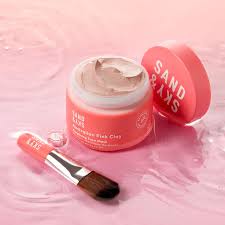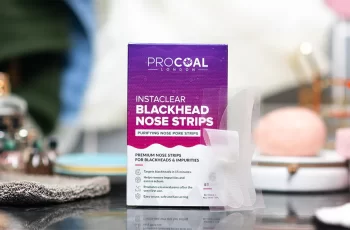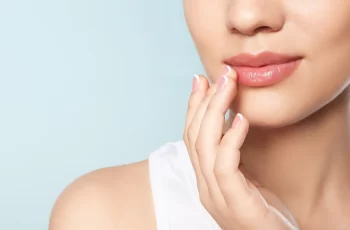What is the difference between Australian pink clay and French pink clay?
Clay masks are the one product without which an at-home spa night would be meaningless! Clay masks are a must-have for pampering your skin, and their popularity dates back centuries, no, literally centuries. Back in 80 BC in ancient Egypt, Queen Cleopatra created a mask using white clay, milk, honey, and olive oil. She applied it all over her body to restore youth and glow to her skin. In the modern century, our love for these masks has not faded, although today we mostly limit them to our faces.
In 2017, clay masks, especially those made from pink clay, have been rising in popularity. But there is more to these Instagram-worthy products that are popular among millennials. The benefits of pink clay are particularly impressive, and every skin type can use it very comfortably. Compared to other clay masks that can be very drying for sensitive skin, pink clay is much gentler and has more of a softening effect on clogged pores, rather than sucking away dirt like other masks do. Pink clay deep cleanses the skin without affecting the skin’s natural oils.
What is pink clay?
Pink clay is a type of clay called kaolin. Kaolin is usually white and takes on a pink hue depending on the iron oxide content. The higher the ratio, the darker the kaolin tone. The clay also becomes more absorbent. Kaolin comes in different shades from red to white. Red is great for oily skin types, and white can be mixed into a variety of mask formulas to provide a soothing effect. Pink is somewhere in between, providing a deep pore cleansing effect while keeping the skin balanced and comfortable.
Skincare Benefits of Pink Clay
Pink clay is suitable for all skin types, especially sensitive and dry skin. It is rich in minerals and locks in moisture, removes impurities, helps regenerate and hydrate the skin, and gently exfoliates the skin due to its slightly grainy texture, revealing a radiant complexion.
For dry and sensitive skin types, pink clay blocks irritation and inflammation while promoting healthy cell turnover, which addresses dry skin issues such as dry, flaky patches on the skin and makes the skin look brighter and smoother. Another reason pink clay is perfect for dry skin types is that the clay doesn’t strip the skin of its natural oils, which keeps it balanced and comfortable.
Dehydrated skin will also notice that the skin feels plumper and more radiant with the help of pink clay, which can be a difficult task in cold temperatures. Luckily, pink clay protects the outer layer of the skin from environmental influences such as weather and pollution.
Oily skin will experience completely different results when using pink clay. Don’t be fooled by the mild effects of this clay on sensitive skin, it’s actually gentle but effective. Congested, acne-prone skin will notice tightened pores, reduced blackheads and blemishes, and no signs of irritation leading to further breakouts.
With toxic air and pollution at their highest levels since 2010, using a pink clay mask at least once a week will keep your skin as healthy as possible. This explains why we’ve doubled the number of people using detoxifying masks. We’ve all had blackheads, blemishes or enlarged pores at one time or another, and using a 10-minute clay mask can easily combat these issues with its powerful, deep cleansing capabilities, clearing away dirt, grime, oil and even makeup from you and your pores. Remove any residue you missed with a cleanser! Once all the grime is gone, you’ll notice a smoother texture on your face, impurities removed and skin rejuvenated.
Masks and treatments for acne and pimples are often too harsh on the skin. In order to achieve the desired “squeaky clean” feeling, every last drop of oil is removed from the skin. This causes the skin to compensate and produce excess oil, which over time can lead to, yes, you guessed it, zits and acne. Opting for a gentler but more effective approach will leave the skin’s natural barrier, pH and sebum production undisturbed and at its healthiest.
As the title of this article suggests, there are different types of pink clay. In the next section, I’ll take the time to explain the difference between Australian pink clay and French pink clay explained.
What’s the difference?
Well, as the names suggest, both clays are harvested in different regions. Geographically, this means they contain different minerals and may have slightly different effects on the skin.
French Pink
Minerals found in pink clay are iron, illite, montmorillonite, and calcite.
Illite is great for acne-prone skin because it unclogs clogged pores. It also stimulates blood circulation, making the skin look tighter and more youthful.
Montmorillonite is super absorbent and gently removes excess oil from the skin without completely degreasing it.
Finally, there’s calcite, a crystal that’s said to be great for energy cleansing, which in my opinion is exactly what should be included in a soothing clay mask. It draws out toxins, gently exfoliates, and removes dead skin cells that make the skin look dull. It stimulates blood circulation and rejuvenates the skin.
French pink clay from the south of France has been used exclusively in spas for luxurious treatments for years, which explains why home skincare products are often more likely to contain Australian pink clay, but its popularity has begun to gain some momentum as more brands choose French pink clay.
Australian Pink Clay
Australian pink clay contains a very different combination of minerals: silica, magnesium, selenium and zinc.
Silica is a natural anti-inflammatory that locks in moisture, which explains why pink clay is perfect for dry and eczema-prone skin types. Magnesium helps the skin retain its natural fatty acids, which is great for keeping your face looking youthful and plump. Selenium is a great antioxidant that neutralizes any harmful free radicals that damage the skin’s natural barrier. Finally, zinc works wonderfully healingly on the skin, treating any blemishes and making them less noticeable, which also makes pink clay a great skincare treatment for mature skin.
Produced in a specific region of Australia, this clay is rich in plant extracts and minerals that work together to shrink pores, detoxify polluted skin, and remove impurities. Due to the purity of the clay, it’s soft yet strong against oil and shine.
French or Australian pink clay is rich in minerals and extracts that fight free radicals, allowing our skin to be optimally cared for. Considering the many aggressors we face every day, using this millennial pink product will help restore your skin to its healthiest state while also adding a luxurious pampering factor!
Don’t miss out on more skincare tips and expert advice on our YouTube channel! Click the “Subscribe” button to visit our green couch. You won’t regret it!
DQH Knowledge drop: In your 20s, your skin cell turnover decreases. (Cell turnover is a key component in keeping your skin youthful.) You know what else slows down? Your collagen production. Starting in your 20s, collagen decreases by about 1 percent per year. Should you want to prevent fine lines and wrinkles, start by eliminating behaviors that contribute to premature aging. “If it’s bad for you, it’s bad for your skin,” says dermatologist Michel Somenek.
“Cigarette smoking reduces blood flow to the skin and causes premature wrinkling and a dull skin texture. Making the repeated pursed motion to inhale can also cause smoker’s lines. Alcohol and recreational drugs are toxins for the skin that damage its cellular structure and DNA,” Somenek tells us. “The faster you eliminate vices while you are young, the better chance your skin and body have to recuperate.” Also, adopting an anti-aging routine in your 20s is key. After all, the best offense is a good defense. We spoke to Somenek and experts Joshua Ross and Audrey Kunin to find out more.
Keep reading for the best anti-aging products for your 20s, according to skincare professionals.
Sunscreen
“We all know that the sun is the number one cause of skin aging and starting the prevention in your 20s is very important,” Ross says. “The majority of your sun damage won’t start to appear until you’re in your 30s, so don’t wait until you see it surface or you’ll be behind the curve. Stay ahead of it with a good-quality zinc-based sunscreen worn daily.”
Farmacy Green Defense Daily Mineral Sunscreen
An invisible sunscreen with SPF 30, plus botanical extracts meant to protect skin with tons of antioxidants. Bonus: It’s clean and fine to use under makeup.
Bareminerals Complexion Rescue™ Tinted Moisturizer Broad Spectrum SPF 30
Although we recommend you use your SPF and moisturizer separately, we also understand moments when you don’t have time or energy for that extra step. For those times, this bareMinerals moisturizer is a great thing to have on hand.
Vitamin C Serum
“A great introduction to anti-aging is to start with a vitamin C serum in your morning skincare routine,” Ross says. “It’s a powerful antioxidant that will neutralize free radicals and brighten the skin.” He adds that it’s a great way to counteract the effects of the sun’s harmful rays, which, as previously mentioned, are among the biggest causes of premature aging.
Drunk Elephant C-Firma™ Vitamin C Day Serum
The Drunk Elephant C-Firma is a lightweight serum that promises to give skin a glow by combining the brightening powers of vitamin C with ferulic acid, l-ascorbic acid, and vitamin E. The included sodium hyaluronate is meant to replace hydration loss, so you shouldn’t have to deal with any irritation.
Sunday Riley C.E.O. Rapid Flash Brightening Serum
This potent serum is jam-packed with vitamin C (15 percent, to be exact), which means it’s a potential superstar at both brightening skin and dousing it in antioxidants.
Peptides
Using peptides on your skin has many benefits, says Somenek. “The skin barrier is what defends the body against pollution, UV rays, bacteria, and toxins. It can be damaged by several everyday factors. Using topical peptides aids in building a stronger barrier,” he says. “Peptides comprise elastic fibers, which are a type of protein. These fibers help to make skin appear taut and firm. Peptides can also help repair damaged skin, relieve inflammation, and even out skin tone. Some peptides can kill acne-causing bacteria that is common in 20-somethings.”
Kunin agrees, saying, “Peptides are an excellent entry point for supporting collagen.” She recommends looking for face and eye treatments that contain these collagen-boosting powerhouses.
Charlotte Tilbury Magic Eye Rescue Cream
This Charlotte Tilbury super-emollient eye cream has a base of coconut oil and shea butter (read: it’s incredibly hydrating). Botanicals plus peptides are meant to help reduce dark circles and boost collagen, respectively.
This creamy moisturizer serves up potent collagen-boosting peptides and pycnogenol, and antioxidant-rich vitamin C. “Instead of sitting on top of the skin, peptides penetrate the outer layer so they go deep. The ‘signals’ they send tell the cells to produce elastin and collagen, which are needed for youthful-looking skin,” explains Somenek.
At-Home Peel Pads
Remember that skin cell turnover fiasco we talked about earlier? One way to help support it is by exfoliating. “Exfoliation is important to help keep skin fresh and luminous,” Kunin says. She recommends using at-home peel pads as an easy and effective way to exfoliate.
“The goal in your 20s is to fight the slowing pace of cell turnover. It is wise to use products that gently exfoliate, yet still remove oil and other impurities. Products that have Alpha Hydroxy Acids (AHA) or Beta Hydroxy Acids (BHA) are a good choice.”
According to Somenek, you should only exfoliate two to three times a week. “People of all ages are guilty of over-exfoliating and that can be too much of a good thing,” he says.
Dermadoctor Kakadu C Intensive Vitamin C Peel Pad
A few swipes of this Derma Doctor powerful peel pad promise to leave your skin glowing and smooth, thanks to the seven (yes, seven) types of chemical exfoliants, including AHA and BHA. It also contains vitamin C via Kakadu plum extract for added brightening and antioxidant protection.
KEY INGREDIENTS Kakadu plum extract is sourced from the Kakadu plum, a fruit grown in northern Australia. It contains vitamin C, which restores the skin’s natural barrier, increases collagen production, and soothes irritation.
Dr. Dennis Gross Skincare Alpha Beta® Universal Daily Peel Pads
These are the gold standard of peel pads, with a cult following and over 900 five-star reviews on Sephora. They’re easy to use and contain a blend of anti-aging exfoliating acids.
Emollient Night Cream
“In your 20s, you need to start upping the hydration in your skincare routine. You may have been cautious of over-moisturizing because of acne in your teens, but as you enter your 20s, your skin transitions and becomes drier,” Ross says. “I recommend an emollient night cream added into your evening skincare regimen.”
“Twenty-somethings need to make sure that they are not using creams that will clog their pores and cause excess oil production,” says Somenek. Opt for non-comedogenic products.
Cerave Skin Renewing Night Cream
One great choice is the CeraVe Skin Renewing Night Cream, which is a non-comedogenic night cream that leaves skin soft and glowy. It combines the moisturizing powers of ceramides and hyaluronic acid.
RoC Retinol Correxion Max Hydration Creme
“The best night cream ingredients contain retinol, benzoyl peroxide, and/or salicylic acid or hyaluronic acid. The goal is to moisturize, yet remove excess oil,” says Somenek. This Roc Retinol Correxion cream fits the bill as it contains both hyaluronic acid and retinol so it promises to moisturize while also being non-comedogenic.



